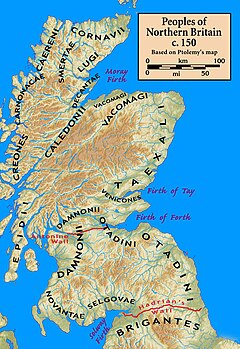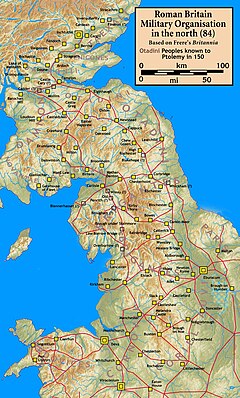Selgovae
The Selgovae (Common Brittonic: *Selgowī) were a Celtic tribe of the late 2nd century AD who lived in what is now Kirkcudbrightshire and Dumfriesshire, on the southern coast of Scotland.
Their name appears in the 8th century Ravenna Cosmography as 'Segloes',[2][broken footnote] but the document here is taken to be an imperfect copy of classical sources such as Ptolemy, and not an independent historical reference.
Uxellum was at Wardlaw Hill at Caerlaverock according to Skene and Horsley; it was noted that the name sounds like Welsh uchel (high) or Gaelic uas, uasal.
They built a significant number of hillforts, more so than their neighbours, which may explain why the Romans targeted them before the relatively less organised and therefore less threatening tribes to the west and north.
This is in contrast to the neighbouring Novantae, where there are no signs of Roman occupation save the fortlet at Gatehouse of Fleet, in the southeast of their territory.
Ptolemy's placement of the Selgovaean town of Trimontium was accepted to be somewhere along the southern coast of Scotland until William Roy (1726–1790) placed it far to the east at Eildon Hills, near Newstead.
Roy did not alter Ptolemy's placement of the Selgovae in southern Scotland, but chose to assign Trimontium to a different people who were described in De Situ Britanniae.
[15] When De Situ Britanniae was debunked as a fraud in 1845, Roy's misguided placement of Trimontium was retained by some historians, though he was no longer cited for his contribution.
Furthermore, some historians not only accepted Roy's placement of Trimontium, but also returned the town to the Selgovae by moving their territory such that they would be near Eildon Hills.
While Roy's historical work is largely ignored due to his unknowing reliance on a fraudulent source, his maps and drawings are untainted, and continue to be held in the highest regard.


